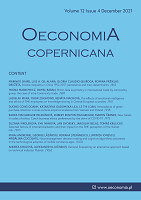Factors influencing structural power dynamics in buyer-supplier relationships: a power sources framework and application of the critical incident technique
Factors influencing structural power dynamics in buyer-supplier relationships: a power sources framework and application of the critical incident technique
Author(s): Dariusz Siemieniako, Paweł KaliszewskiSubject(s): Business Economy / Management
Published by: Instytut Badań Gospodarczych
Keywords: power dynamics; power asymmetry; buyer-supplier relationship; critical incident technique; manufacturing;
Summary/Abstract: Research background: Although the literature on power asymmetry and power dynamics has recognized the issue of factors that cause power shifts in business-to-business relationships, a more systematic approach and research framework regarding the identification of these factors is lacking. There are attempts in business-to-business literature to use the critical incident technique to study dynamic phenomena, but there are no studies on the factors that increase and decrease the power of suppliers in their relationships with dominant buyers. Purpose of the article: The aim of this paper is to identify the factors that influence the most significant changes in suppliers? power in relationships with dominant buyers. An important objective is also to determine to which power sources the identified factors are assigned. This is crucial for business practitioners, who will be able to adjust their actions when managing a relationship with a dominating partner through knowledge of their own strengths as well as weaknesses. Methods: The study is based on analysis of questionnaires with open-ended questions, and uses the critical incident technique to investigate the behaviour of dyadic parties at key moments in buyer-seller relationships. We have focused on investigation of manufacturing companies mainly from the furniture, construction, energy and printing industries. The analysis of the data was based on the abductive approach as a combination of inductive and deductive coding. Findings & value added: In comparison to previous studies, which did not distinguish the level of importance of each factor, we have obtained only those factors with the greatest impact on power dynamics. We have also obtained factors which can decrease suppliers? power, whereas the literature focuses mostly on factors increasing suppliers? power. The research results reveal the factors that affect an increase and decrease in the power of weaker suppliers in relationships with dominant buyers. First- and second-order factors were identified, and subsequently 3 overarching dimensions for each increase and decrease in supplier power were deduced from the results. The most important overall dimension for the increase in power was the building of suppliers' power capabilities, while the decrease in suppliers' power was most influenced by transactional changes and changes in buyer's expectations. The results can be helpful for managers in focusing their attention on expert power in order to gain knowledge and prepare a practical background for managing asymmetric relationships. It is important to mention that the critical incident technique used in this study has not yet been used to represent power dynamics in B2B relationship literature.
Journal: Oeconomia Copernicana
- Issue Year: 13/2022
- Issue No: 1
- Page Range: 151-179
- Page Count: 29
- Language: English

